Monthly economic brief: July 2021
The monthly economic brief provides a summary of latest key economic statistics, forecasts and analysis on the Scottish economy.
This document is part of a collection
Labour Market
Labour market indicators continue to strengthen as restrictions have eased.
Coronavirus Jobs Retention Scheme (CJRS)[9]
- The CJRS continues to provide significant support to businesses and the labour market (set to remain in place until September 2021) however the number of jobs supported by the scheme has fallen as businesses have resumed trading following the easing of restrictions.
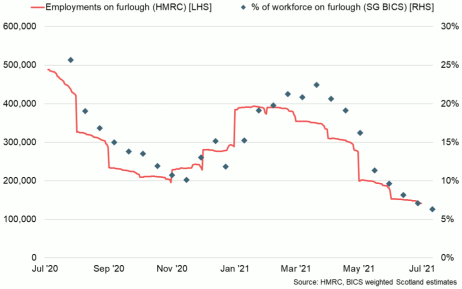
- At the end of June, 141,500 jobs in Scotland (6%) were furloughed, its lowest point in the time series, and is down from 175,300 (8%) at the end of May and from the recent peak of 393,400 in January during the recent lockdown. More recent business survey data indicates that the proportion of staff on furlough continued to fall into the first half of July.[10]
- The composition of furlough has also changed notably in recent months as business have required more flexibility as lockdown restrictions have eased and businesses have reopened at different levels of capacity. At the end of February during lockdown, 70% of jobs on furlough were fully furloughed (30% partially), however this has been gradually reversing and in June, 48% of jobs furloughed were fully furloughed and 52% were flexibly furloughed.
- At a sector level, HMRC data show consumer facing servicies such as accommodation and food (31,900) and wholesale and retail (19,300) continue to have the highest number of employments on furlough, however they have also had the largest falls as restrictions on the consumer facing services sector have eased and businesses in the sector have resumed trading. Business survey data indicates that this pattern continued, though with some volatility at the start of July.[11]
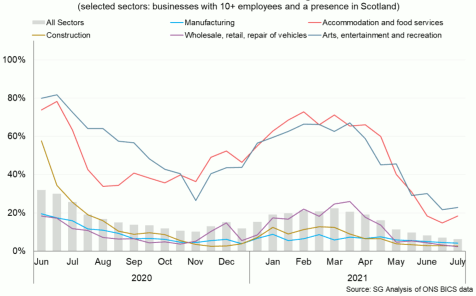
Official labour market statistics
- The latest labour market statistics for March – May 2021 show Scotland’s employment rate was 74.0% (up 0.3 percentage points over the year),[12] the unemployment rate was 4.4% (down 0.1 percentage points) and the inactivity rate was 22.6% (down 0.2 percentage points).
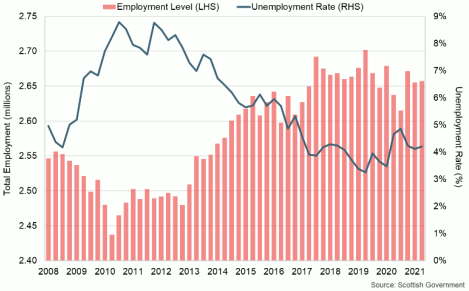
- The headline labour market indicators continue to compare well against historical trends, however they only show a partial picture as people on furlough are considered employed. Wider labour market indicators provide further insight into the challenges that have emerged in the labour market during the pandemic and the signs of improvement in recent months.
PAYE payrolled employment and Claimant Count
- Pay As You Earn (PAYE) Real Time Information data for June show that the number of payrolled employees in Scotland (2.37 million) increased by 27,080 (1.2%) over the month and has increased by 64,779 (2.8%) from its recent low in November.
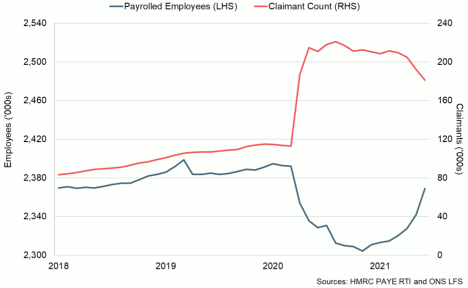
- This is the highest number of payrolled employees in Scotland since March 2020, however remains 23,872 (1.0%) lower than its pre-pandemic level in February 2020.[13]
- The change in payrolled staff continues to vary regionally in Scotland. In June, annual growth in payrolled employees was highest in Lochaber, Skye and Lochalsh, Arran and Cumbrae and Argyll and Bute, with a rise of 6.6%.
- UK level data signals that the initial recovery in payroll numbers was largely confined to the over 50’s age group, however over May and June, there has been stronger growth in 18-24 aged employees. This likely reflects the easing of restrictions on accommodation and food services which saw a notable increase in employees over May and June and which are key employers of young people.
- Alongside this, Scotland’s Claimant Count (the number of claimants of Job Seekers Allowance and claimants of Universal Credit claiming principally for the reason of being unemployed) fell 5.8% in June to 181,200; a claimant count rate of 5.7%. The claimant count continued its recent downward trend and has fallen 18% from its peak in August 2020, however, remains 67,500 (59%) higher than its pre-pandemic level in February 2020.[14]
- Combined, the claimant count and payroll data signal that the number of people that have been unemployed or employed with low income and/or low hours have increased significantly during the pandemic. However, the movements back to pre-pandemic levels shows that progress in the labour market recovery has been made with ongoing support from the Job Retention Scheme.
Demand for staff
- Business survey data also provides evidence of strengthening demand for staff and recruitment activity in recent months as restrictions have eased and firms have resumed further trading activity.
- In June, demand for both temporary and permanent staff in Scotland continued to increase and was broad based across the majority of sectors.[15]
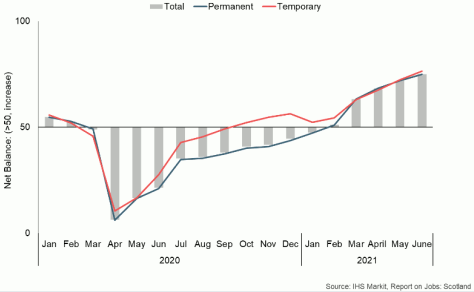
- This corresponds with UK vacancy data for April to June 2021 which showed UK job vacancies grew 39% over the quarter and was 9.9% (77,500) above its pre-pandemic level in Q1 2020.
- At a sector level, UK vacancy growth over the quarter was broad based across the private sector, but sharpest in sectors such as arts entertainment and recreation (up 330%) and accommodation and food services (up 257%) which were recruiting staff as restrictions in these sectors eased. In the latter, the ONS reported that the rise in vacancies in part reflected some evidence of a shortage of skilled staff in the sector and of employees finding alternative areas of employment prior to the sector reopening.[16]
Earnings
- Mean PAYE monthly pay fell sharply at the start of the pandemic, however strengthened over the course of 2020 and rebounded back above its pre-pandemic level in July 2020. Relatively robust earnings growth over this period in part reflects lower inflows of new employees, for which mean pay tends to be around 40% lower than for those continuously employed.[17]
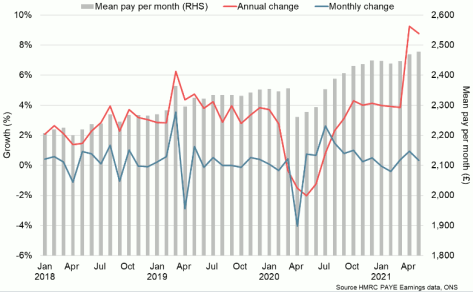
- Following a slight fall at the start of 2021, latest data for May shows pay growth in Scotland has returned to positive in recent months, growing 0.3% over the month to £2,478. On an annual basis earnings growth slightly tapered off to 8.8% in May, however remains elevated, which in part reflects the sharp fall in mean earnings at the start of the pandemic.
- While mean earnings have rebounded on an annual basis, this needs to be interpreted with caution. The ONS note that it has been affected by a changing composition of employee jobs, with a fall in the number and proportion of lower-paid employee jobs. This acts to increase average pay, with underlying annual wage growth for the UK estimated to be between 2.2 to 3.4 percentage points lower than headline annual wage growth.
Contact
Email: OCEABusiness@gov.scot
There is a problem
Thanks for your feedback